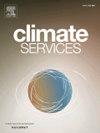Climate change perceptions and adaptation responses among smallholder farmers across three locations in Megech Watershed, Ethiopia
IF 4
3区 环境科学与生态学
Q2 ENVIRONMENTAL SCIENCES
引用次数: 0
Abstract
Climate change significantly affects smallholder farmers in Ethiopia who rely on rain-fed agriculture for their livelihoods. Farmers’ perceptions of climate change can modify their adaptation response decisions. However, there is limited knowledge about the key constraints that hinder the adoption of climate change measures in the Megech watershed. This research aimed to assess the smallholder farmers’ perception regarding climate change and the factors influencing their decision to adopt adaptation measures. This research employed a multi-stage sampling procedure to select a sample of 385 smallholder farmer households. Structured and semi-structured questionnaires were designed to conduct a household survey and focus group discussion for data purposes. Furthermore, this study covered a comparison between the farmers’ perspectives on climate change and the observed climate trends. The data analysis was done by descriptive statistics and logistic regression equation. Results showed that the primary sources for most farmers to get information about climate change were extension workers, radio broadcasts, and religious institutions. The majority of farmers believed that climate change was attributed to deforestation, population growth, and industrialization. Almost all farmers were cognizant of the temperature rise, aligning with the observed trend. However, the perception of the farmers on declining rainfall aligns only with recent rainfall trends. Farmers in the downstream had more experience in adopting climate change resilience strategies than farmers in the mid and upstream. On average, 87% of the farmers applied adaptation measures, including intensive inputs (fertilizers), planting date changes, and improved varieties. The farmers’ adoption of adaptation strategies was hampered by challenges such as limited access to credit and high costs of agricultural inputs. The regression analysis revealed that age, education, extension and credit access, and livestock size significantly affected the decision to adopt adaptation measures. These findings may support policymakers in formulating location-based adaptation measures to enhance resilience to climate change.
埃塞俄比亚Megech流域三个地点小农对气候变化的认知和适应反应
气候变化严重影响了埃塞俄比亚依靠雨养农业为生的小农。农民对气候变化的认知可以改变他们的适应响应决策。然而,人们对阻碍在Megech流域采取气候变化措施的关键制约因素的了解有限。本研究旨在评估小农对气候变化的认知以及影响其采取适应措施决策的因素。本研究采用多阶段抽样方法,选取385户小农家庭为样本。设计结构化和半结构化问卷进行住户调查和焦点小组讨论,以获取数据。此外,本研究还将农民对气候变化的看法与观测到的气候趋势进行了比较。数据分析采用描述性统计和logistic回归方程。结果表明,大多数农民获取气候变化信息的主要来源是推广人员、无线电广播和宗教机构。大多数农民认为气候变化是由森林砍伐、人口增长和工业化造成的。几乎所有的农民都意识到了气温的上升,这与观测到的趋势一致。然而,农民对降雨量下降的看法只与最近的降雨趋势一致。在采取气候变化适应战略方面,下游农民比中上游农民更有经验。平均而言,87%的农民采取了适应措施,包括集约化投入品(肥料)、改变种植日期和改良品种。农民采取适应战略受到诸如获得信贷机会有限和农业投入成本高等挑战的阻碍。回归分析显示,年龄、教育程度、推广和信贷获取以及牲畜规模显著影响采取适应措施的决策。这些发现可能支持决策者制定基于地点的适应措施,以增强对气候变化的适应能力。
本文章由计算机程序翻译,如有差异,请以英文原文为准。
求助全文
约1分钟内获得全文
求助全文
来源期刊

Climate Services
Multiple-
CiteScore
5.30
自引率
15.60%
发文量
62
期刊介绍:
The journal Climate Services publishes research with a focus on science-based and user-specific climate information underpinning climate services, ultimately to assist society to adapt to climate change. Climate Services brings science and practice closer together. The journal addresses both researchers in the field of climate service research, and stakeholders and practitioners interested in or already applying climate services. It serves as a means of communication, dialogue and exchange between researchers and stakeholders. Climate services pioneers novel research areas that directly refer to how climate information can be applied in methodologies and tools for adaptation to climate change. It publishes best practice examples, case studies as well as theories, methods and data analysis with a clear connection to climate services. The focus of the published work is often multi-disciplinary, case-specific, tailored to specific sectors and strongly application-oriented. To offer a suitable outlet for such studies, Climate Services journal introduced a new section in the research article type. The research article contains a classical scientific part as well as a section with easily understandable practical implications for policy makers and practitioners. The journal''s focus is on the use and usability of climate information for adaptation purposes underpinning climate services.
 求助内容:
求助内容: 应助结果提醒方式:
应助结果提醒方式:


